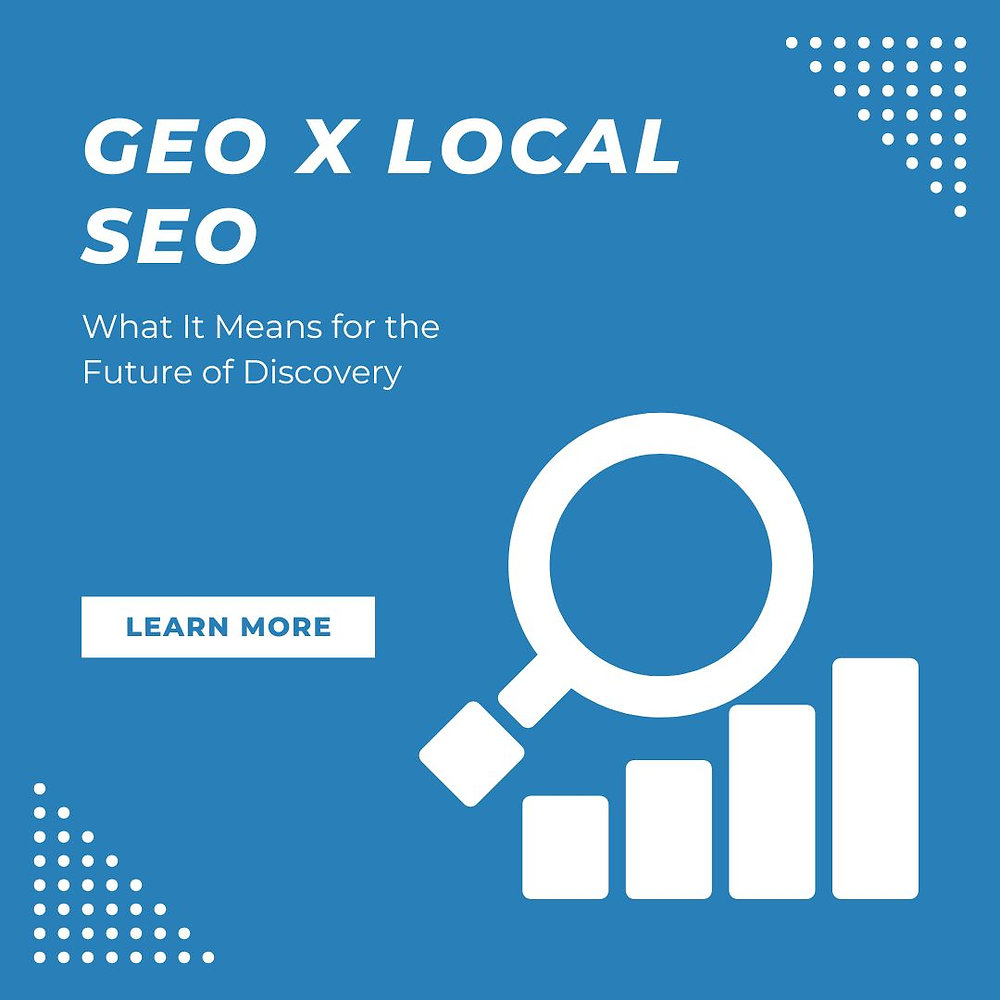Tel: +918968331866
Email: dkpp.57@gmail.com

GEO x local SEO: What It Means for the Future of Discovery
0
23
0

Search is no longer just about keywords and rankings. The rise of AI-powered search engines, conversational interfaces, and zero-click results has fundamentally altered how users discover businesses, services, and content. Local SEO, once a tactical game of optimizing for “near me” queries and Google Business Profiles, is evolving into something more nuanced and strategic.
This evolution is encapsulated in the concept of GEO—Geographic Entity Optimization. GEO represents a shift from traditional local SEO toward a model where businesses must be recognized, understood, and cited by AI systems. In this new paradigm, visibility is not just about appearing in search results; it’s about being the answer that AI systems trust and recommend.
From Keywords to Entities: Why GEO Matters
Historically, local SEO revolved around keyword targeting, proximity signals, and structured data. Businesses optimized for phrases like “best dentist in Ludhiana” or “24/7 plumber near me,” hoping to appear in the local pack or organic listings. But with the rise of AI-generated answers—especially in tools like Google’s AI Overviews, Bing Chat, and ChatGPT—the focus has shifted.
AI systems don’t just match keywords. They interpret intent, understand context, and surface entities they deem authoritative. This means businesses must now optimize not just for search engines, but for AI comprehension. GEO is the framework that enables this transition.
What Is Geographic Entity Optimization?
GEO is the practice of optimizing a business’s digital presence so that it is recognized as a reliable, contextually relevant entity by AI systems. It goes beyond traditional SEO by focusing on:
Entity relationships and contextual relevance
Conversational content that aligns with natural language queries
Structured data that AI can parse and interpret
Trust signals from authoritative sources
In short, GEO is about training AI systems to understand your business as the best possible answer to location-specific questions.
The Rise of Zero-Click Discovery
One of the most significant changes in search behavior is the rise of zero-click results. More than half of all searches now end without a user clicking through to a website. Instead, users get their answers directly from AI-generated summaries, featured snippets, or knowledge panels.
This trend has major implications for local businesses. If your business is not cited in these AI-generated answers, you’re effectively invisible—even if you rank well in traditional search results. GEO helps ensure that your business is not just visible, but cited and trusted by AI systems.
Key Components of GEO Strategy
To succeed in the GEO era, businesses must rethink their local SEO strategies. Here are the core components of a GEO-driven approach:
1. Entity Optimization
AI systems prioritize entities—people, places, organizations—based on their relationships, context, and trustworthiness. Optimizing your entity means ensuring that your business is consistently represented across platforms, with rich contextual data that AI can understand.
This includes:
Consistent NAP (Name, Address, Phone) data across directories
Detailed service descriptions
Mentions of partnerships, affiliations, and community involvement
Structured schema markup that defines your business attributes
2. Conversational Content
AI systems respond to natural language queries. Your content must reflect how people actually ask questions. Instead of optimizing for “emergency plumber Ludhiana,” create content that answers:
“Can I get a plumber to fix a burst pipe in Ludhiana tonight?”
“Who offers same-day AC repair in Ludhiana East?”
This type of content is more likely to be cited by AI systems because it aligns with user intent and provides actionable information.
3. Structured Data and Schema Markup
Schema markup is essential for helping AI systems understand your content. Basic local business schema is no longer sufficient. You need to implement:
FAQ schema for common questions
Service schema with detailed offerings
Review schema to highlight customer feedback
Event schema for workshops, promotions, or community events
The goal is to make your content machine-readable and contextually rich.
4. Comparison and Decision-Making Content
AI systems often surface content that helps users make decisions. Creating comparison pages—such as “Top 5 HVAC companies in Ludhiana East”—with genuine data and balanced analysis increases your chances of being cited.
Include:
Service features
Pricing transparency
Customer reviews
Unique selling points
This positions your business as a helpful resource rather than a promotional pitch.
Auditing Your AI Visibility
Before you can optimize for GEO, you need to understand how AI systems currently perceive your business. One effective method is using deterministic AI prompts with zero randomness—often referred to as the “Temperature 0.0” method.
How to Audit:
Use platforms like OpenAI Playground or Google AI Studio with the following settings:
Temperature: 0.0
Top-p: 1.0
Then ask questions like:
“[Your Business Name] is known for…”
“Compare [Your Business Name] to other [industry] providers in [location]”
“Best [service] companies in [city] include…”
Document the responses to see how your business is described, whether it’s cited, and how it compares to competitors.
Competitive Analysis
Run the same prompts for your competitors. Analyze:
Language used to describe them
Attributes and trust signals
Gaps in your own representation
This helps identify areas where you can improve your entity optimization and citation potential.
Building Citation-Worthy Content
Once you understand your current AI footprint, the next step is to create content that AI systems want to cite. This involves:
1. Task-Oriented Content
Focus on helping users complete tasks. Instead of generic service pages, write content that answers specific questions:
“How quickly can I get a leaking faucet fixed in Ludhiana?”
“What’s the best bakery near Model Town for eggless cakes?”
Provide clear, detailed answers with natural language and actionable information.
2. Content Clusters and Semantic Relationships
Build clusters of related content that reflect the full customer journey. For example:
Causes of plumbing issues
Signs you need emergency service
Cost estimates
Booking process
Link these pages together to create semantic depth and topical authority.
3. Enhanced Schema and Structured Data
Go beyond basic schema. Include:
Service areas with geo-coordinates
Holiday hours and emergency availability
Detailed service descriptions
Staff bios and certifications
This helps AI systems understand your business in context and increases citation potential.
Reviews and Trust Signals
AI systems are cautious about recommending businesses. They rely heavily on trust signals, especially reviews. Encourage customers to leave detailed, authentic reviews that mention:
Specific services
Outcomes
Timeliness
Professionalism
Ensure consistency across platforms like Google, Yelp, Facebook, and industry-specific directories.
Measuring Success in the GEO Era
Traditional SEO metrics like keyword rankings and organic traffic don’t fully capture your AI visibility. You need new KPIs:
1. AI Citation Frequency
Track how often your business is mentioned in AI-generated answers across platforms. Use consistent prompts and document changes over time.
2. Sentiment and Accuracy
Analyze how your business is described:
Is the tone positive?
Are the details accurate?
Are your unique selling points highlighted?
Use this data to refine your content and entity optimization.
3. Cross-Platform Recognition
Test your business across multiple AI platforms. Look for:
Consistent naming and branding
Accurate service descriptions
Recognition in competitive queries
Inconsistencies indicate areas for improvement.
Strategic Implications for Founders and Marketers
For founders like Darsh Panaich, who are building platforms like Trends in Marketing, GEO offers a scalable framework for AI-friendly content architecture. Here’s how to apply it:
1. Category Structuring
Design categories that reflect user intent and task completion. Examples:
“Tools for Regional SEO”
“AI Citation Strategies”
“Case Studies in GEO Optimization”
Use schema markup and internal linking to build semantic relationships.
2. Funnel Mapping
Align AI citations with funnel stages:
Awareness: Mentioned in broad queries
Consideration: Cited in comparison content
Conversion: Featured in task-specific answers
Track how AI visibility influences conversion rates and refine your strategy accordingly.
3. Data-Driven Content Creation
Use entity audits and citation tracking to guide content development. Focus on:
Filling gaps in AI understanding
Strengthening trust signals
Enhancing contextual relevance
This ensures every piece of content contributes to AI discoverability.
Conclusion: Owning the Future of Discovery
GEO x Local SEO is not a trend—it’s a strategic shift in how businesses are discovered, evaluated, and recommended. In a world where AI systems mediate most search experiences, being cited is more valuable than being ranked.
Businesses that embrace GEO will dominate not just local packs, but AI-generated answers, voice search, and zero-click experiences. They’ll be the ones AI systems trust to solve real problems in real time.
For digital strategists, founders, and marketers, GEO is the blueprint for building lasting visibility in an AI-first world. It’s not just about being found—it’s about being understood, trusted, and chosen.






